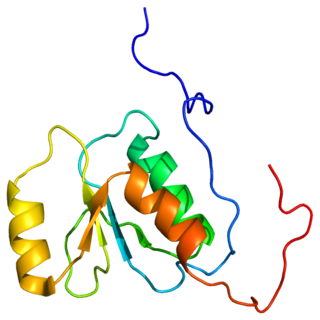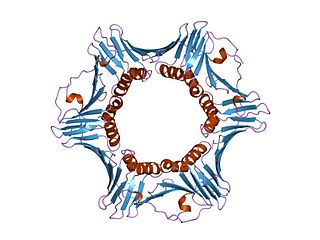Replication factor C subunit 2 is a protein that in humans is encoded by the RFC2 gene. [5] [6] [7]
Replication factor C subunit 2 is a protein that in humans is encoded by the RFC2 gene. [5] [6] [7]
The elongation of primed DNA templates by DNA polymerase delta and epsilon requires the action of the accessory proteins, proliferating cell nuclear antigen (PCNA) and replication factor C (RFC). RFC, also called activator 1, is a protein complex consisting of five distinct subunits of 145, 40, 38, 37, and 36.5 kD. This gene encodes the 40 kD subunit, which has been shown to be responsible for binding ATP. Deletion of this gene has been associated with Williams syndrome. Alternatively spliced transcript variants encoding distinct isoforms have been described. [7]
RFC2 has been shown to interact with BRD4, [8] CHTF18, [9] [10] PCNA, [11] [12] [13] RFC4 [11] [14] and RFC5. [11] [14]
The replication factor C, or RFC, is a five-subunit protein complex that is required for DNA replication.

Proliferating cell nuclear antigen (PCNA) is a DNA clamp that acts as a processivity factor for DNA polymerase δ in eukaryotic cells and is essential for replication. PCNA is a homotrimer and achieves its processivity by encircling the DNA, where it acts as a scaffold to recruit proteins involved in DNA replication, DNA repair, chromatin remodeling and epigenetics.

p21Cip1, also known as cyclin-dependent kinase inhibitor 1 or CDK-interacting protein 1, is a cyclin-dependent kinase inhibitor (CKI) that is capable of inhibiting all cyclin/CDK complexes, though is primarily associated with inhibition of CDK2. p21 represents a major target of p53 activity and thus is associated with linking DNA damage to cell cycle arrest. This protein is encoded by the CDKN1A gene located on chromosome 6 (6p21.2) in humans.

A DNA clamp, also known as a sliding clamp, is a protein complex that serves as a processivity-promoting factor in DNA replication. As a critical component of the DNA polymerase III holoenzyme, the clamp protein binds DNA polymerase and prevents this enzyme from dissociating from the template DNA strand. The clamp-polymerase protein–protein interactions are stronger and more specific than the direct interactions between the polymerase and the template DNA strand; because one of the rate-limiting steps in the DNA synthesis reaction is the association of the polymerase with the DNA template, the presence of the sliding clamp dramatically increases the number of nucleotides that the polymerase can add to the growing strand per association event. The presence of the DNA clamp can increase the rate of DNA synthesis up to 1,000-fold compared with a nonprocessive polymerase.

Eukaryotic DNA replication is a conserved mechanism that restricts DNA replication to once per cell cycle. Eukaryotic DNA replication of chromosomal DNA is central for the duplication of a cell and is necessary for the maintenance of the eukaryotic genome.

Ku70 is a protein that, in humans, is encoded by the XRCC6 gene.

Cell cycle checkpoint protein RAD17 is a protein that in humans is encoded by the RAD17 gene.

Flap endonuclease 1 is an enzyme that in humans is encoded by the FEN1 gene.

Replication factor C subunit 1 is a protein that in humans is encoded by the RFC1 gene.

Cyclin-O is a protein that in humans is encoded by the CCNO gene.

Replication factor C subunit 4 is a protein that in humans is encoded by the RFC4 gene.

Replication factor C subunit 3 is a protein that in humans is encoded by the RFC3 gene.

Replication factor C subunit 5 is a protein that in humans is encoded by the RFC5 gene.

DNA polymerase delta subunit 2 is an enzyme that in humans is encoded by the POLD2 gene. It is a component of the DNA polymerase delta complex.

Sister chromatid cohesion protein DCC1 is a protein that in humans is encoded by the DSCC1 gene.

DNA polymerase delta subunit 3 is an enzyme that in humans is encoded by the POLD3 gene. It is a component of the DNA polymerase delta complex.

Chromosome transmission fidelity protein 8 homolog is a protein that in humans is encoded by the CHTF8 gene.

Chromosome transmission fidelity protein 18 homolog is a protein that in humans is encoded by the CHTF18 gene.
Sister chromatid cohesion refers to the process by which sister chromatids are paired and held together during certain phases of the cell cycle. Establishment of sister chromatid cohesion is the process by which chromatin-associated cohesin protein becomes competent to physically bind together the sister chromatids. In general, cohesion is established during S phase as DNA is replicated, and is lost when chromosomes segregate during mitosis and meiosis. Some studies have suggested that cohesion aids in aligning the kinetochores during mitosis by forcing the kinetochores to face opposite cell poles.

DNA polymerase epsilon catalytic subunit is an enzyme that in humans is encoded by the POLE gene. It is the central catalytic subunit of DNA polymerase epsilon.